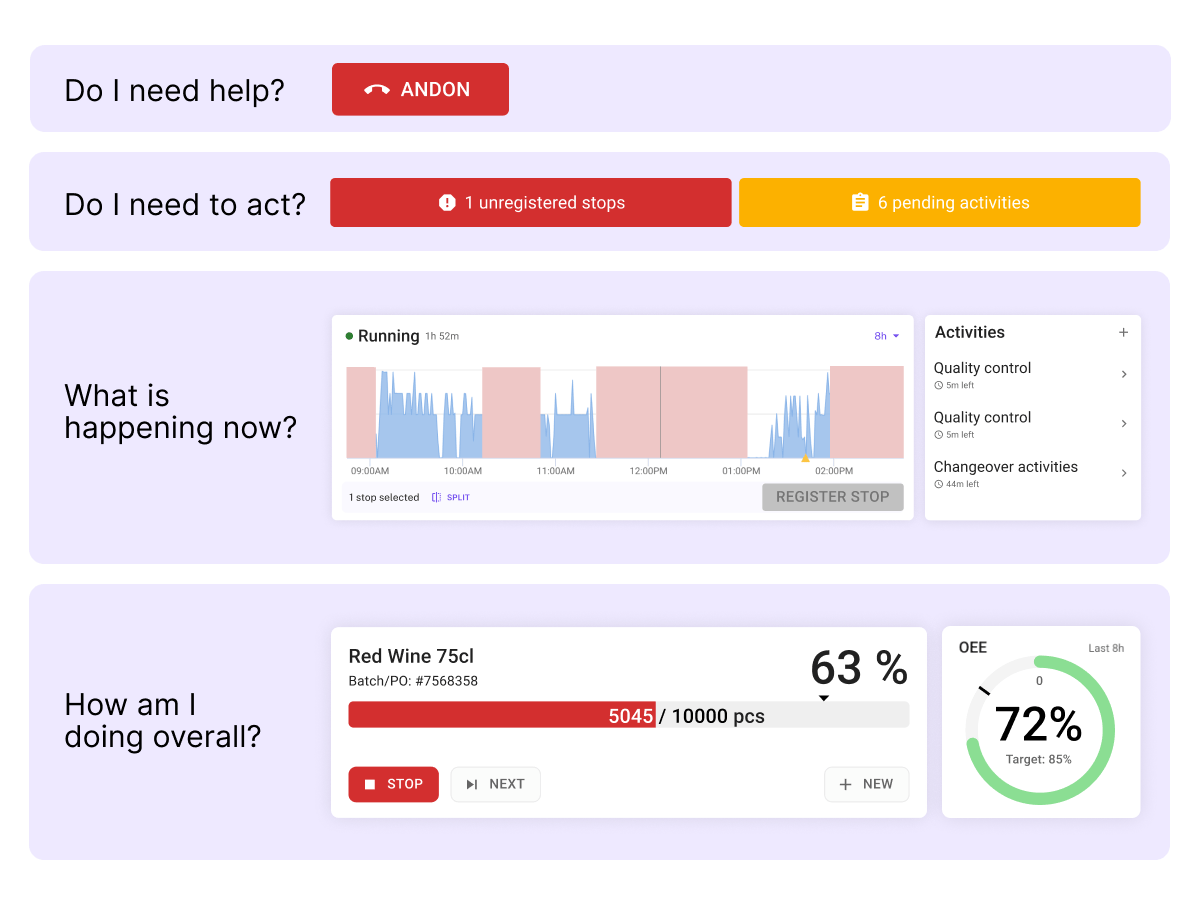The hidden cost of cognitive overload in manufacturing
Operator cognitive overload affects your bottom line. Learn its causes and get solutions that reduce friction, improve data, and boost overall performance.

Walk into almost any factory, and you’ll see the same scene: operators juggling sheets of paper and screens while trying to keep the line running. They are asked to monitor machines, record stops, handle changeovers, perform quality checks, and keep production on track.
On paper, this layer of admin makes sense. In practice, however, the complexity compounds and is a silent drain on performance.
Every extra sheet of paper, screen, login, or click just adds more friction to getting the job done. The impact may seem trivial in isolation, but across weeks, months, and years, the costs become enormous.
One study of digital work found people lose nearly four hours per week just reorienting after switching between applications; that’s roughly five weeks a year, per person!
On the factory floor, not only is the time loss from context switching significant, but friction also means slower responses to stops, less accurate reporting, inaccurate analysis, and exhaustion.
Cognitive overload for operators: more than fatigue
Cognitive overload occurs when demands on attention outpace our capacity. Too many alerts, cluttered interfaces, or poorly structured workflows force operators to divide their focus.
Evidence shows task switching and interruptions increase mental workload and degrade performance, especially as task complexity rises. Workers experiencing a heavy cognitive load are slower to react, more likely to make mistakes, and often overlook key information.
The consequences of cognitive overload are clear in manufacturing. Overall Equipment Effectiveness (OEE) metrics become inaccurate and lose their value. Managers start making decisions based on flawed data.
[CTA]
This state of “continuous partial attention” is worse than just declining performance – it damages the decision-making itself. For leaders in manufacturing, the takeaway here is that complexity at the operator level doesn’t stay there; it spreads into reporting, forecasting, and profitability.
When inefficiencies multiply
It’s tempting to dismiss a few lost seconds here and there as harmless. But when those seconds are added up and then multiplied across dozens of operators, multiple lines, and global networks, the math quickly becomes brutal.
Ten minutes wasted per shift becomes an hour per operator every week. A plant with 100 operators would then lose 100 hours weekly. Spread that further across a large enterprise, and these inefficiencies translate into millions in labor costs and lost output.
Fragmented systems bring another hidden risk: inconsistency. If each site uses different tools and inconsistent definitions of downtime, comparing performance becomes completely meaningless. You end up chasing shadows instead of addressing the real bottlenecks and problems. Such confusion is one of the main reasons global improvement programs stall. Organizations can’t scale best practices when the frontline works with and measures through different tools.
Real-world strain: voices from the floor
At Danish Crown, Europe’s largest meat processor, cognitive overload was more than just a theoretical problem. Operators using earlier versions of digital tools often skipped registering minor stops because the registration process was too cumbersome. Expectedly, this led to gaps in their data and OEE metrics that couldn’t be trusted.
Mikkel Simonsen, Senior Manager, Operational Insights at Danish Crown, explains it plainly: “As a principle, our data is considered unreliable if more than ~4% of our stops go unregistered. That puts pressure on the tools we use. The more intuitive, user-friendly, and accurate those tools are, the more useful the data we get. With the Operator View, we’re now able to register stops much more consistently, and it’s easier to stay within the threshold.”
“As a principle, our data is considered unreliable if more than ~4% of our stops go unregistered.”
– Mikkel Simonsen, Danish Crown
This is the hidden cost of complexity: not just the minutes lost, but poor or compromised insights that blossom into flawed strategies.
The reality of cognitive overload on the shop floor
Cognitive overload doesn’t announce itself in dramatic fashion but rather slowly seeps in as a series of small frictions. All the extra clicks, unclear priorities, and cluttered navigation don’t signal dramatic failure. But each one chips away at focus, precision, and morale.
Here are some examples.
Stop registration
There’s a stop, so the operator clears the jam, gets production running again, then sets to work on documenting it. Often this means looking through a long list of reason codes on a separate web page or sheet of paper. It takes time to log, and production is running again. This hassle leads to minor stops getting skipped and OEE getting fuzzy.
Quality check execution
Routine quality check notifications are often hidden in long task lists with weak priority cues. They’re often done late or out of sequence, risking waste, delays, and rework.
Batch transition
Changeovers often mean jumping between tabs on a screen and paper documents: one to queue the next batch, another for the checklist, and a third to split downtime events. It’s easy to miss a step and leave patchy data for the next shift.
In general, what we hear from operations leaders is that they want their operators producing, not distracted by systems and screens. Producing the product is exactly what pays everyone's salary and wages on a manufacturing site, and not all the time spent away from doing that. This results in a potential loss of margin and sales.
One easy-to-use interface for operators
So how do you engage the operator without distracting them from what they need to do?
Our answer is Operator View, an easy-to-use interface built for operators in Factbird’s manufacturing intelligence suite.
Factbird’s Operator View is the go-to interface for operators during their day:
- Monitor line status and upcoming activities at a glance.
- Log stops quickly with visual prompts.
- Handle batch transitions.
- Complete quality checks and other activities with guided steps.
- Request support without leaving the interface.

We built Operator View alongside our customers to make sure it fulfilled the real needs of people on the shop floor. Key concepts that guided the process were:
- Big, loud, obvious: know what’s happening in seconds.
- One–two taps: any outcome in 1–2 actions.
- Fast onboarding: intuitive from day one.
- Instant feedback: see if you’re winning or losing at a glance.
So what we're doing here with the Operator View is leveraging the discretionary efforts of everyone on the shop floor. Our approach involves a plug-and-play visual factory and a user-friendly interface, which engages everyone on the shop floor in continuous improvement.
By consolidating all the essential tasks operators perform into a single, user-friendly interface, Operator View minimizes the need for frequent mental adjustments. The work and the documentation happen together and in the same flow.
Impact on adoption, onboarding, and training
Complex systems slow down adoption and frustrate new hires. Operators will avoid clunky interfaces like the plague, and managers are forced into spending time on retraining rather than focusing on how to improve performance.
Our intuitive Operator View addresses this thanks to intentional simplicity and human-centered design. Visual cues guide operators through all their tasks. The display, layout, and functions are intuitive enough that training takes up less time, and seasoned operators actually prefer using it.
As one Danish Crown worker put it, “by collecting everything the operators need in a single interface, they don’t need to jump between windows or pages to do their work. The changes help them stay focused on registering accurately, rather than navigating systems.”
And the research backs this up: clearer, easier instructions lower cognitive load and improve speed and accuracy.
Reliable visibility for leaders
With Operator View, Production Managers get the benefit of accurate, complete downtime data that supports root cause analysis. For Operations Directors, it brings a trustworthy clarity and visibility across multiple sites.
Mikkel Simonsen, Senior Manager, Operational Insights at Danish Crown, summarizes the enterprise value:
“By placing OEE at the center, the [Operator View] can provide both the reliability of complete operator-level data and the transparency of live performance insights. This combination is essential for building trustworthy insights, enabling faster reactions, and driving stronger performance management in both daily operations and long-term improvements.”
The human factor
Beyond metrics, there is an important cultural signal here. When operators are given clear, streamlined tools, it also demonstrates an understanding that their time is valued. That’s a gesture that builds engagement, trust, and morale. Operators who feel supported notice problems sooner, suggest improvements more often, and become active contributors to performance gains.
On the other hand, only providing them with fragmented systems signals that the struggles of operators are invisible. Over time, this disengagement becomes just as costly as the lost minutes of production.
From complexity to clarity
Margins in manufacturing are under relentless pressure. Volatile pricing, fluctuating demand, and rising expectations around traceability leave no room for wasted or misplaced effort. Reducing operator complexity is one of the most direct ways to secure efficiency.
It improves OEE by cutting errors. It accelerates adoption and makes onboarding easier. It strengthens your data integrity so decision-makers can scale improvements. And it signals recognition and respect for the people who keep factories running.
Our Operator View proves that digital transformation doesn’t necessarily mean adding more tools, more actions, or more clicks. The true value comes from trimming down the distractions and removing clutter, reducing friction, and bringing clarity to operators.
Cognitive overload is already costing you. The question is how much and how quickly you can eliminate it.
You can find out more about how Operator View works here, or get in touch with us to try it out yourself.

